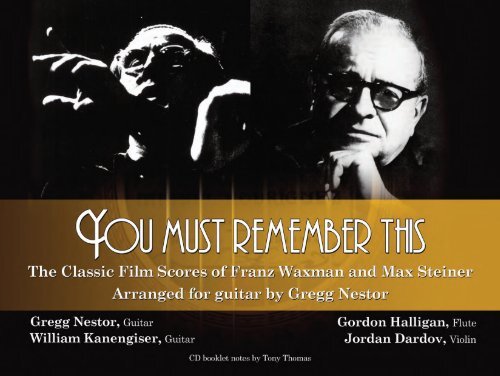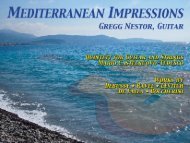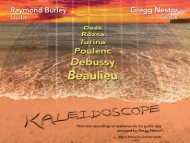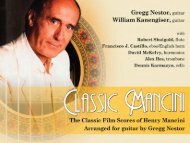Download You Must Remember This CD Full-Color Digital Booklet
Download You Must Remember This CD Full-Color Digital Booklet
Download You Must Remember This CD Full-Color Digital Booklet
Create successful ePaper yourself
Turn your PDF publications into a flip-book with our unique Google optimized e-Paper software.
Album Produced by Gregg NestorAll Arrangements by Gregg NestorRecorded at Penguin Recording, Eagle Rock, CARecording Dates: May 20, 22, 24 1986, June 8, 9 1987Engineer: John StrotherMicrophones: AKG 460 CK1 / Neumann KM 84<strong>Digital</strong>ly Recorded on F1<strong>Digital</strong> Preparation by CMS <strong>Digital</strong>Engineer: Bill GiolandoAlbum Art Direction: Mark BanningMr. Nestor’s Guitar by Martin Fleeson, 1981Mr. Kanengiser’s Guitar by Miguel Rodriguez, 1977Special Thanks to Danny and Joel Franklin at Warner Bros Music for access to Steiner’s scoresand to John Waxman for access to his father’s scores.With gratitude and appreciation to the memory ofTony Thomas, author extraordinaire.
May 10th, 1988 will mark the centenary of Max Steiner’s birth. It istherefore most timely that Gregg Nestor and William Kanengisercollaborate to produce a recording honoring Max Steiner and FranzWaxman on this occasion. The selections Mr. Nestor has chosen forhis two guitar renditions are most appropriate, since they representthe wide breadth of their musical vocabulary. <strong>This</strong> recording will bewell received by Franz Waxman and Max Steiner fans around theworld.Albert Bender, Director-FounderThe Max Steiner Memorial Society - May, 1988The musical art is almost as integral a part of the motion picture as is theart of photography. Even “silent” films had some form of musicalaccompaniment, while the vast majority of all sound films rely heavily onmusic to enhance their emotional ambience. Yet pity the poor filmcomposer. Almost always under considerable pressure, he or she writesan extended “score”, generally containing some thirty to forty-fiveminutes worth of music, although sometimes considerably more, whichthen gets edited into an art form where the rule of thumb is that music isto be “seen” and not heard. To make matters worse, once the filmdisappears, its music disappears with it, unless it makes its way to a“soundtrack” (actually music track) recording or, on infinitely rareoccasions, gets performed in a concert suite. What we hear on thisrecording, however, is precisely that: concert arrangements, of variouslengths, for two guitars (with occasional flute or violin), by guitarist GreggNestor, from scores by two of the earliest practitioners of this specializedart form, Franz Waxman and Max Steiner.FRANZ WAXMAN (1906-1967)Franz Waxman was born in 1906 (the same year as Dmitri Shostakovich)in Upper Silesia, then a part of Germany but now annexed to Poland.Waxman began working in film at the very beginning of the sound era.While still in Germany, he orchestrated and conducted FrederickHollander’s score for Josef von Sternberg’s famous The Blue Angel. In1934, at the age of 28, he followed Erich Pommer, then head of Berlin’sUFA Studios, to Hollywood as arranger for the film musical, Music In TheAir, with a score by Jerome Kern and Oscar Hammerstein II. Waxman’sfirst original score for Hollywood, The Bride Of Frankenstein (1935),stands as one of the most innovative and appropriate musicalaccompaniments for earlysound film. It reveals Waxmannot only as a composer ofmemorable themes but alsoan expert creator of mood viadark, chromatic harmoniesand frequently offbeatinstrumentations.For the next thirty-two years,Franz Waxman composed andconducted 144 motion picturescores in Hollywood; he wasnominated for the AcademyAward 10 times and wontwice in a row in 1950 and1951. In 1947, Waxman founded the Los Angeles International MusicFestival, presenting over seventy World, American and West Coastpremieres by such composers as Bernstein, Mahler, Poulenc,Schoenberg, Shostakovich, Stravinsky, Vaughan Williams and Sir WilliamWalton. He frequently guest-conducted orchestras in the United States,Europe, Israel and in 1962 was chosen to be the first American, as part ofthe cultural exchange program, to conduct the major orchestras of theSoviet Union.THE MUSIC OF FRANZ WAXMAN1. “HUCKLEBERRY FINN” OVERTURE (2:23)Huckleberry; On The Mississippi; Huckleberry (Reprise)Waxman composed Huckleberry Finn for a 1939 Metro-Goldwyn-Mayermovie showcasing young Mickey Rooney as Huck and Rex Ingram asJim. The “Overture” that opens this recording, however, is based on anarrangement by orchestrator Christopher Palmer from a piece Waxmanhad put together from his score to be used as a radio promotion for thefilm. The opening and closing sections of this overture features a quasibanjo,hoe-down type of theme that immediately evokes the AmericanSouth while also, in its jauntiness, painting a portrait of Mark Twain’sfamous character. The central episode, on the other hand, is a barcarolle
that musically portrays Huck and Jim’s meanderings on the Mississippi.After a Grand Pause, the jaunty theme returns; the two guitars playfullydescending in chromatic parallel scales before their final exuberantsummation.2. “PEYTON PLACE” SUITE (7:02)Introduction; Going To School; Main Title; ‘Peyton Place’ Theme (“TheWonderful Season Of Love”); Hilltop Scene; First Kiss; Constance(Fugato)Of all Waxman’s film scores, Peyton Place is probably the best known.Penned in 1957 for the film adaptation, produced by Jerry Wald anddirected by Mark Robson, of Grace Metalious’ soap-opera roman-à-clefs,the music was described by its composer as “essentially in the ‘youth’character: it is simple in invention, simple in its harmonies and simple inits development and orchestration. I have tried to capture the atmosphereof the New England landscape by actually using melodies from the NewEngland folklore for many of my themes. The others were composed withthe idea of coming as close as possible in character and invention to thisfolklore.” In the suite recorded here, we first hear the solemn, marcatofigure that introduces the main titles; in its demanding two-guitararrangement, it has an even “folkier” sound to it than in its orchestralguise. <strong>This</strong> is followed by a snippet from the scherzo-like theme “GoingTo School” that appears at several points in the film. Following the ratherheroic “Main Title”, the Peyton Place theme, a nostalgic, very romantictune popularized as “The Wonderful Season Of Love”, makes itsappearance- its poignancy further emphasized with supported notesplayed campanella (ringing bell-like tones) in the second guitar. Theintroduction theme quietly re-emerges played in delicate artificialharmonics, setting up the Coplandesque return of the scherzo for the“Hilltop Scene”. For “The First Kiss”, naturally the romantic themeresurfaces in a more harmonically complex fashion. The three-voicefugato “Constance” that closes this suite brings back the scherzo theme:the opposing voices of the music parallel the opposing sides of motherand daughter in the film.An interesting side-note is that Mr. Nestor edited the final recording ofthis suite during a week spent in Camden, Maine - the actual townfeatured as Peyton Place in the film.3. KATSUMI LOVE THEME FROM “SAYONARA” (3:13)With Gordon Halligan, fluteSayonara (1957) is based on James A. Michener’s bestselling novel oftwo opposing cultures. Marlon Brando gives a sensitive performance;however it is Miyoshi Umeki (Katsumi) and Red Buttons’ Oscar winningperformances (Best Supporting Actress/Actor) as the star-crossed loverscaught in anti-Japanese prejudice by the American army in Tokyo duringthe Korean War that were Waxman’s inspiration for the “Katsumi LoveTheme.” Waxman was reluctant at first to accept the assignment tocompose the score for Sayonara because Irving Berlin had alreadywritten the title song. However producer William Goetz and directorJoshua Logan gave him complete artistic freedom. He created one of themost tender scores and, as Warner Bros.’ Music Director Ray Heindorfpredicted, one of the most memorable melodies which became aninternational standard.After a brief introduction, solo flute introduces the theme accompanied byincidental figures in the music strongly evoking the film’s Japanesesettings. The work eventually modulates the key of B Major, this time setagainst the flowing harmonies and pizzicato accompaniment before itsquiet and soulful conclusion.Irving Berlin graciously congratulated Waxman not only on thearrangement of his song in the film but on the beauty of the “KatsumiLove Theme.”4. “PHILADELPHIA STORY” SUITE (3:22)Main Title; ‘The True Love’ ThemeFranz Waxman’s versatility can be easily appreciated when you considerthat he wrote the scores for both Rebecca and Philadelphia Storyalmost simultaneously in 1940. George Cukor’s delightful film version ofPhilip Barry’s play (which later became the Cole Porter musical film HighSociety) was a tour de force for the star-studded cast of KatherineHepburn, Cary Grant and James Stewart. Stewart won the AcademyAward and both Hepburn and Cukor were nominated respectively for BestActress and Best Director.A virtuosic flourish dramatically heralds “The True Love” Theme – a
THE MUSIC OF MAX STEINER7. “ROME ADVENTURE” MAIN TITLE (2:03)Scored in 1962 towards the end of Steiner’s career, Rome Adventuretells the story of a young American (Troy Donahue), who pilots his motorscooter in and out of the love lives of Angie Dickinson and SuzannePleshette in a jigsaw romance through the Italian Alps, Florence andVenice. The “Main Title” for this lavish production is classic Steiner; a bigromantic theme in which nothing, not even the kinds of chromaticharmonies one hears in Waxman’s scores, stands in the way of themelody.8. LOVE THEME FROM “SUGARFOOT” (3:31)The 1959 Sugarfoot, later retitled Swirl Of Glory, is a Randolph ScottWestern. The “Love Theme”, which opens with a moody introductionfeaturing atmospheric parallel chords typical of many of Steiner’s bestefforts is, for all of its romanticism, a much less ‘open’ sounding themethan Rome Adventure.9. WALTZ FROM “JEZEBEL” (2:04)William Wyler’s 1938 Jezebel represented, among other things, WarnerBros.’ attempt to undercut the Selznick Studios’ Gone With The Wind bycasting Bette Davis, who had been under consideration for the role ofScarlett O’Hara, as a Scarlettesque, scheming Southern belle (Davis wonher second Oscar for her efforts). In Jezebel’s famous swirling waltz,Davis dances with Henry Fonda, having scandalized all of New Orleanssociety by showing up in a shocking red gown. For the Vienna bornSteiner, of course, writing waltzes was all but second nature.10. “THE TREASURE OF THE SIERRA MADRE” SUITE (4:26)Sierra; Pardners; Martyr (The Letter); Texas Memories;Pardners (Reprise)Steiner’s music for the late John Huston’s 1948 classic The Treasure OfThe Sierra Madre, immediately evokes the film’s Mexican setting withsome quasi-Flamenco flourishes. The unlikely trio of Humphrey Bogart, inan out-of-type role as Fred C. Dobbs, Tim Holt and Walter Huston, isportrayed in the bouncy rough-and-tumble “Pardners” tune, while themore darkly hued strains and poignant melody of “Martyr” accompanythe reading of a letter carried by a murdered Texan who has wanderedinto the “Pardners” camp. “Texas Memories” is a lilting piece of Mexicana(with the guitars imitating the sound of mandolins used in the full score).The gloomier mood in the final reprise of “Pardners” depicts the ironicconclusion of the film. The gold that Dobbs has so zealously guarded andultimately died for is blown away by desert winds back to the mountainsfrom whence it came- a sardonic twist of fate.11. LOVE THEME FROM “SINCE YOU WENT AWAY” (2:00)Since <strong>You</strong> Went Away, whose World-War-II-at-home screenplay waswritten by none other than producer David O. Selznick, won Steiner, in hislast score for Selznick, the 1944 “Best Score” Oscar (his third);interestingly, Selznick had called in Steiner at the last minute afterrejecting a complete musical treatment by Alexandre Tansman (longassociated with the guitar through his longstanding collaboration with thelate Andrés Segovia). The famous theme heard here evokes the ill-fatedlove affair between the characters played by Robert Walker and JenniferJones.12. “CASABLANCA” SUITE (5:57)Refuge; Market Scene; Orders; ‘As Time Goes By’;Romance (Barcarolle); “Deutschland über alles”; La MarseillaiseMichael Curtiz’s 1942 Casablanca is, of course, one of the most popularfilms ever shot. Set during the early stages of World War II, Casablancaopens with a sequence in which a narrator tells of the refugees who areflocking to the Morrocan port following the fall of France. Behind this, wehear one of Steiner’s most acerbic themes, “Refuge”, punctuated bydroning, dissonant chords. In strong contrast, the ensuing musicalsequence deploys all the standard Mid-East tropes to paint theCasablancan market place. A brief allusion to the French national anthem,“La Marseillaise”, introduces “As Time Goes By”, a song composed byHerman Hupfeld in 1931 that never really took off until it resurfaced inCasablanca. In this suite, we not only hear “As Time Goes By” stated in astraightforward solo guitar version by Mr. Nestor but also in variousdramatic guises as the tune leaves the narrative. (<strong>This</strong> type of chromaticmodulation appears frequently in Steiner’s opus - never more beautifullythan here). For a brief moment towards the end of the suite, we hear anaudacious, contrapuntal juxtaposition of “As Time Goes By” and“Deutschland über alles” that follows the shooting of the Nazi officer and
that succinctly sums up much of what Casablanca is all about. And in afinal tribute to the bond between Rick Blaine (Humphrey Bogart) and theFrench police prefect played by Claude Rains, the suite, like the film,closes on an optimistic affirmation of “La Marseillaise”.13. THEME FROM “A SUMMER PLACE” (2:22)The 1959 film A Summer Place was one of the numerous film soapoperas scored by Steiner. The “adolescent love” tune, rockish in its beatand memorable in its melody and instrumentation, became one of the tophits of the late Fifties. Here its sensual atmosphere is highlighted thesecond time through with delicate artificial harmonics deftly played byMr. Kanengiser.14. TARANTELLA FROM “THE FLAME & THE ARROW” (1:46)The “Tarantella” that follows A Summer Place is music for a danceheard in the 1951 film, The Flame And The Arrow, directed by JacquesTourneur and starring Burt Lancaster as a victorious rebel leader inmedieval Italy. It serves here as a highly virtuosic and infectious displaypiece. Steiner later reused this work in Rome Adventure.15. “GONE WITH THE WIND” SUITE (15:31)Selznick Trademark (Newman); Forward (Dixie); Tara Theme; Mammy;O’Hara; Katie Bell; Prayer In Despair; Ashley And Scarlett; UnrequitedLove; Rhett Butler; Belle And Melanie In Carriage; Charleston Heel AndToe Polka; Southern Belle Waltz; Can-Can; Melanie (Love Theme); Tara;In The Radish Field; Affirmation And Oath; Tara (Reprise - ‘Tomorrow IsAnother Day…’)Finally, we arrive at what is probably the most famous film score of alltime, Gone With The Wind, produced in 1939 by David O. Selznick anddirected by Victor Fleming. For this nearly four-hour long Civil War epic,Steiner, along with a battery of orchestrators, arrangers and even othercomposers who added snippets to the score here and there (two briefcues taken from earlier Franz Waxman scores also appear in the film), puttogether three hours worth of music, some two and a half of which madeit, as the longest “sound” film score in history to that date, to Gone WithThe Wind’s music track. In order to accomplish this in the ridiculouslyshort period of time he was given, Steiner worked under the constantsupervision of a doctor who frequently prescribed medication to keep thecomposer going. The result is the very prototype of the lush, sweepinglyromantic, symphonic film score, and one that immortalized Max Steinerfor all time.At the outset of the suite presented here, we hear the logo theme for theSelznick Studios composed in 1937 by Alfred Newman. Steiner’s scoreopens with a brief allusion to”Dixie” to set the film’s locale; the musiccrescendos into the famous “Tara” melody, a love theme if ever therewas one but first and foremost a tune intended to evoke the splendor,grandeur and nostalgia inherent in the heroine’s “Tara” plantation and allthat it stood for in the old South before the Civil War. Gone With The Windis also a leitmotif score: besides Tara, each of the principal characters hashis/her own theme, as do many of the supporting characters. There arealso two distinct love themes, one for Ashley and Melanie (Leslie Howardand Olivia de Havilland) and one for Rhett and Scarlett (Clark Gable andVivien Leigh). Many of these themes, which appear in various guisesthroughout the score depending upon the particular dramatic situation,can be heard in this suite, the titles of which are self-explanatory foranyone who has seen the film- and who hasn’t seen Gone With TheWind at least once?Also included are three dances- “Charleston Heel And Toe Polka”,“Southern Bell Waltz” and “Can-Can”- heard here in their complete formrather than the fragmented version from the film. A brief reprise ofvarious themes previously presented leads to the final “Affirmation AndOath”. Here Steiner magically captures Scarlett’s destitution, frustrationand subsequent vow for self-sufficiency in a breathtaking sequence ofchromatic modulations against which is heard distorted fragments of the“Tara” theme. <strong>This</strong> theme now gathers itself up into a dramatic andemotionally charged conclusion reaffirming Scarlett’s proud defiance anddetermination to succeed against all adversity and, at the same time,reflecting Steiner’s majestic and triumphant expression of his art.<strong>CD</strong> booklet notes byTony Thomas
COPYRIGHT CREDITSFRANZ WAXMAN:HUCKLEBERRY FINN – Copyright 1939 Loews, Inc. /Renewed 1966, MGM, Inc.PEYTON PLACE- Copyright 1958 Twentieth Century Music Corp. /Renewed 1986, 20th Century-Fox Music Corp.KATSUMI LOVE THEME (“Sayonara”) –Copyright 1957 M. Witmark & Sons/Renewed 1985, Warner Bros. Music, Inc.THE PHILADELPHIA STORY – Copyright 1939 Loews, Inc. /Renewed 1967, MGM, Inc.THE WISHING STAR (“Taras Bulba”) –Copyright 1962 United Artists Music Co.ROSANNA (“Hemingway’s Adventures Of A <strong>You</strong>ng Man”) –Copyright 1962 20th Century Fox Music Corp.All compositions by MAX STEINER controlled by Warner Bros. Music,including Mr. Nestor’s published arrangement of CASABLANCA.Max Steiner has had a Memorial Society in his honor since 1965 and isstill operating as THE MAX STEINER MEMORIAL SOCIETY, P.O. Box 45713,Los Angeles, CA, 90045.Information on the music of FRANZ WAXMAN can be obtained by writingin care of FIDELIO MUSIC PUBLISHING COMPANY, 39 Danbury Avenue,Westport, Connecticut 06880-6822.THE PERFORMERSGREGG NESTOR, guitarInternationally acclaimed guitaristGregg Nestor has built up astrong following for his abilities assoloist, accompanist andarranger. Finalist in the 1981 NewYork Concert Artists GuildCompetition (one of 16 out of2,800 competitors) held atCarnegie Hall, Gregg Nestor hasrecorded and broadcast inHolland, Belgium and Spain, andfor the BBC (England). He was engaged by the British National Trust for aseries of summer concerts in Stately homes throughout England, and hasappeared with members of the London Symphony and Royal Ballet. In hisLondon debut, The Times critic commented on his being “uncommonlycommunicative, a real artist in timing and shading, in stylish fluency andtact besides wholehearted communication with his composers”.Over 40 works arranged by Gregg Nestor for solo/duo guitars or withvarious ensemble have been published. “The arrangements bringtogether high-quality musicianship and the use of characteristic guitarmusicaltextures and devices” says John Duarte of England’s “Music andMusicians”. His “Twelve Folksong Arrangements”, an anthology of songsby Copland, Britten and Seiber is published by Boosey and Hawkes. Onthe lighter side, a new anthology of classic Gershwin tunes (called ‘BYGEORGE’) as well as his arrangement for two guitars of “CASABLANCA”SUITE by Max Steiner (as performed on <strong>You</strong> <strong>Must</strong> <strong>Remember</strong> <strong>This</strong>,Volume One) is published with Warner Bros. Music.Gregg Nestor’s first compact disc release (Pantheon D10761) features anew guitar sonata written in 1986 by Miklós Rózsa at Mr. Nestor’srequest, and published by G. Schirmer.For this recording he was allowed access to the Music Department ofWarner Bros. Music (Burbank Studios) for direct study of the Max Steiner
archives, and to the personal collection compiled by Franz Waxman’s son,John. The results are arrangements as true and concise as possible tothe respective composers’ original intentions and wishes.Mr. Nestor’s guitar is heard on the left channel.WILLIAM KANENGISER,guitarKnown worldwide for his talentsas soloist and chambermusician, William Kanengiserwas awarded First Prize at the1987 Concert ArtistsInternational New YorkCompetition. He received hisBachelor’s and Masters Degreesfrom the University of SouthernCalifornia, and was twice namedthe Outstanding Graduate of theUSC School of Music, where heis currently an Adjunct Professorof Guitar. In his Milwaukeedebut, the Sentinel critic wrote of his being “a classic musician,performing with a manifest love for his instrument and an embracingsense of musical style”. In 1981, he won First Prize in the TorontoInternational Guitar Competition, and in 1983 was awarded top honors inthe Radio-France Competition in Paris with the late Andrés Segovia ashead juror. He has recorded with flutist Hubert Laws and pianist ChickCorea on Columbia Masterworks, and was classical guitar coach anddouble for actor Ralph Macchio in the Columbia Pictures film“Crossroads”.Mr. Kanengiser’s performing career as soloist and a founding member ofthe Los Angeles Guitar Quartet has taken him to concert venuesthroughout Europe and North America. He has played at the“Guitarstreams” International Festival at Carnegie Hall, the Toronto GuitarFestival, the Paca Peña Guitar Festival in Cordoba, Spain and at theConcertgebouw in Amsterdam. He has produced an instructional video,“Effortless Classical Guitar” and has been profiled in a feature interviewof Guitar Player Magazine.Also known for his expertise as an arranger, Mr. Kanengiser hastranscribed extensively for the Los Angeles Guitar Quartet. Theirperformance of his arrangement of the complete ballet “El Amor Brujo”by Manuel de Falla as well as other premieres is heard on a CompactDisc release (GHA <strong>CD</strong> 126001). His solo guitar arrangements of Mozartand Handel keyboard works are published by Guitar Solo Publications.Mr. Kanengiser’s guitar is heard on the right channel.GORDON HALLIGAN, fluteGordon Halligan studied privately with Julius Bakerat the Juilliard School Of Music and hasparticipated in master classes with James Galway,Jean-Pierre Rampal and David Shostac. He hasappeared at Paul Hall (Juilliard School, LincolnCenter), Gindi Auditorium (University of Judaism,Los Angeles) and is in much demand as a recitalistand chamber music performer.JORDAN DARDOV, violinJordan Dardov graduated fromSofia University, Bulgaria in1981. Since 1983, he has beenconcertising throughout Europein solo recitals and withchamber orchestras. Mr.Dardov is frequently heard onconcert platforms in SouthernCalifornia, is actively engagedin the recording industry in LosAngeles and is a member of the string ensemble Masterpiece Virtuosi.
THE MUSIC OF FRANZ WAXMAN1. “HUCKLEBERRY FINN” - Overture (2:23)2. “PEYTON PLACE” - Suite (7:02)3. “SAYONARA” - Katsumi Love Theme (3:13)Featuring Gordon Halligan, flute4. “PHILADELPHIA STORY” - Suite (3:22)5. “TARAS BULBA” - The Wishing Star (2:42)Gregg Nestor, solo guitar6. “HEMINGWAY’S ADVENTURES OF A YOUNG MAN” -Rosanna’s Theme (3:36)Featuring Jordan Dardov, violinTHE MUSIC OF MAX STEINER7. “ROME ADVENTURE” - Main Title (2:03)8. “SUGARFOOT” - Love Theme (3:31)9. “JEZEBEL” - Waltz (2:04)10. “THE TREASURE OFTHE SIERRA MADRE” - Suite (4:26)11. “SINCE YOU WENT AWAY” - Love Theme (2:00)12. “CASABLANCA “ - Suite (5:57)13. “A SUMMER PLACE” - Theme (2:22)14. “THE FLAME AND THE ARROW” - Tarantella (1:46)15. “GONE WITH THE WIND” - Suite (15:31)Total Time: 63:34 2013 Gregg Nestor. All Rights Reserved.Released by BSX Records, A Division of BuySoundtrax.com • 2828 Cochran Street #287, Simi Valley, California 93065







